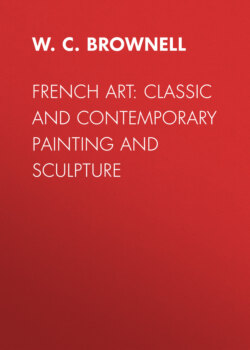French Art: Classic and Contemporary Painting and Sculpture

Реклама. ООО «ЛитРес», ИНН: 7719571260.
Оглавление
W. C. Brownell. French Art: Classic and Contemporary Painting and Sculpture
French Art: Classic and Contemporary Painting and Sculpture
Table of Contents
I
CLASSIC PAINTING
I
II
III
IV
V
VI
II
ROMANTIC PAINTING
I
II
III
IV
V
III
REALISTIC PAINTING
I
II
III
IV
V
VI
VII
VIII
IV
CLASSIC SCULPTURE
I
II
III
IV
V
VI
V
ACADEMIC SCULPTURE
I
II
III
IV
V
VI
VII
VIII
VI
THE NEW MOVEMENT IN SCULPTURE
I
II
Отрывок из книги
W. C. Brownell
Published by Good Press, 2019
.....
But the business of intelligent criticism is to be in touch with everything. "Tout comprendre, c'est tout pardonner," as the French ethical maxim has it, may be modified into the true motto of æsthetic criticism, "Tout comprendre, c'est tout justifier." Of course, by "criticism" one does not mean pedagogy, as so many people constantly imagine, nor does justifying everything include bad drawing. But as Lebrun, for example, is not nowadays held up as a model to young painters, and is not to be accused of bad drawing, why do we so entirely dispense ourselves from comprehending him at all? Lebrun is, perhaps, not a painter of enough personal importance to repay attentive consideration, and historic importance does not greatly concern criticism. But we pass him by on the ground of his conventionality, without remembering that what appears conventional to us was in his case not only sincerity but aggressive enthusiasm. If there ever was a painter who exercised what creative and imaginative faculty he had with an absolute gusto, Lebrun did so. He interested his contemporaries immensely; no painter ever ruled more unrivalled. He fails to interest us because we have another point of view. We believe in our point of view and disbelieve in his as a matter of course; and it would be self-contradictory to say, in the interests of critical catholicity, that in our opinion his may be as sound as our own. But to say that he has no point of view whatever—to say, in general, that modern classic art is perfunctory and mere formulary—is to be guilty of what has always been the inherent vice of protestantism in all fields of mental activity.
Nowhere has protestantism exhibited this defect more palpably than in the course of evolution of schools of painting. Pre-Raphaelitism is perhaps the only exception, and pre-Raphaelitism was a violent and emotional counter-revolution rather than a movement characterized by catholicity of critical appreciation. Literary criticism is certainly full of similar intolerance; though when Gautier talks about Racine, or Zola about "Mes Haines," or Mr. Howells about Scott, the polemic temper, the temper most opposed to the critical, is very generally recognized. And in spite of their admirable accomplishment in various branches of literature, these writers will never quite recover from the misfortune of having preoccupied themselves as critics with the defects instead of the qualities of what is classic. Yet the protestantism of the successive schools of painting against the errors of their predecessors has something even more crass about it. Contemporary painters and critics thoroughly alive, and fully in the contemporary æsthetic current, so far from appreciating modern classic art sympathetically, are apt to admire the old masters themselves mainly on technical grounds, and not at all to enter into their general æsthetic attitude. The feeling of contemporary painters and critics (except, of course, historical critics) for Raphael's genius is the opposite of cordial. We are out of touch with the "Disputa," with angels and prophets seated on clouds, with halos and wings, with such inconsistencies as the "Doge praying" in a picture of the marriage of St. Catherine, with the mystic marriage itself. Raphael's grace of line and suave space-filling shapes are mainly what we think of; the rest we call convention. We are become literal and exacting, addicted to the pedantry of the prescriptive, if not of the prosaic.
.....